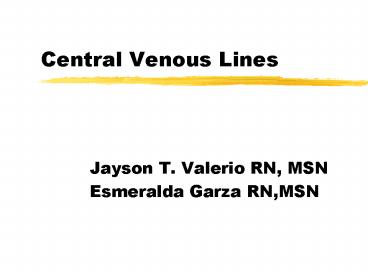Central Venous Lines - PowerPoint PPT Presentation
1 / 19
Title:
Central Venous Lines
Description:
... double or triple lumen at the tip. Insertion: ... Hickman-Broviac double-lumen catheter ... Silastic catheter with up to 3 lumens. Similar to Broviac and Hickman ... – PowerPoint PPT presentation
Number of Views:4567
Avg rating:3.0/5.0
Title: Central Venous Lines
1
Central Venous Lines
- Jayson T. Valerio RN, MSN
- Esmeralda Garza RN,MSN
2
Central Venous Lines
- Mr. WC, 77, has osteomyelitis and receives 1 gram
of vancomycin q 24 hours via central venous line.
Attempting to flush the catheter and get a blood
return before infusing his next dose, you
encounter a lot of resistance and cant aspirate
blood. What could have happened to the line? What
are your nursing responsibilities in taking care
of a client with central lines.
3
What is it called ?
- Central Line?
- Central Venous Line?
- Central Venous catheter?
- CVL?
- CVC?
- Whatever you may want to call it A catheter is
- passed through a vein and into the thoracic
cavity - and into the vena cava or right atrium of the
heart. - A catheter line is considered to be a central
line when - the catheter tip is located at the Superior Vena
Cava or - Inferior Vena Cava
4
Types of Intravenous Access Methods
- Port A Cath - Mediport
- Hickman-Broviac
- Groshong
- PICC
5
Port A Cath, Mediport
- A small metal chamber (1x1x1/2 inch) with a
rubber top that is surgically implanted
underneath the skin to the right of the chest or
arm.
6
(No Transcript)
7
Hickman-Broviac Catheters
- Thin, long tube made of polymeric silicone
rubber extremely flexible and soft - may have either a single, double or triple lumen
at the tip
8
Insertion
- Generally inserted into the cephalic, subclavian,
external or internal jugular vein with the distal
tip advanced to just above the right atrium. The
proximal end exits via a subcutaneous tunnel from
the lower anterior chest wall. A felt cuff
(Dacron) is used to anchor it in place
subcutaneously.
9
(No Transcript)
10
- Hickman-Broviac double-lumen catheter
- smaller Broviac line often used for
administration of IV therapy (parenteral
nutrition or fat emulsions) - should be irrigated between different infusions
to prevent mixing of incompatible solutions,
development of precipitation and resultant
catheter occlusion - larger Hickman line reserved for additional
venous access and blood withdrawal - should be irrigated with heparinized saline after
blood withdrawal to prevent clot formation in the
catheter lumen
11
Groshong Catheter
- Silastic catheter with up to 3 lumens
- Similar to Broviac and Hickman
- Catheter tip is rounded and closed
- Smaller more flexible catheter with less trauma
to entrance site and tunnel - Valve opens inward for blood aspiration and
outward for infusion but remains closed when not
in use - The fluid in the catheter does not come in
contact with the patients blood
12
(No Transcript)
13
- Clamping and frequent heparin flushing are not
necessary since the valve is in closed position. - Weekly flushing with saline is all that is
required to keep the catheter patent. - Advantage easier maintenance
- 3 to 7 times more likely than Hickman catheters
to suffer valve-related catheter malfunction
14
PICC Lines
- Peripherally Inserted Central Catheter
- Long plastic catheter that is inserted into the
arm and threaded through the brachial vein into
the tip of the right atrium (superior vena cava)
15
- Used when long-term IV therapy is needed and the
patient has poor venous access or - needs several weeks of IV antibiotic therapy
- can be left in for up to 12 months if there are
no complications
16
Care of PICC
- Dressings changed first 24 hrs, then once every 7
days or prn (done by trained nurse) - If PICC line is not being used, it will need to
be flushed once a week - Disadvantages Limits arm mobility
- bathing swimming
prohibited
17
Flushing
- Syringe size recommended for use with catheters
- All PICC, Groshong, Broviac, Hickman, and
implanted ports limit of 25 psi - Higher pressure may damage blood vessels and
viscous - 10cc syringe or larger is recommended to infuse
or flush catheters. This includes pediatric and
neonatal catheters. - Use of 3cc syringe generates pressure in excess
of 25 psi 10cc syringe generates less than 8psi
of pressure .
18
Flushing
19
Possible complications
- Infection
- Phlebitis
- Thrombosis or clotting
- Break or cut in the PICC (split line)
- Failure to bleed back
- Catheter dislodgement
- Catheter migration
- Pinch-off syndrome































